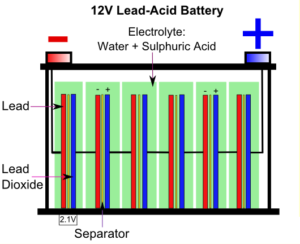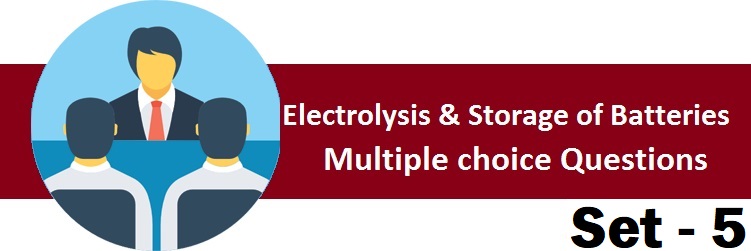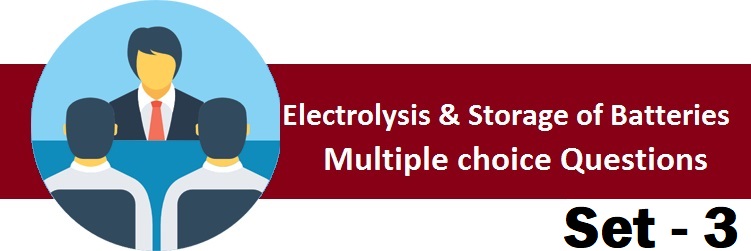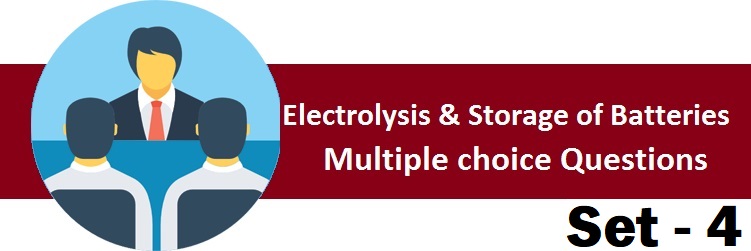Primary and Secondary Batteries
An electric battery consists of a number of electrochemical cells, connected either in series or parallel. A cell, which is the basic unit of a battery, may be defined as a power generating device, which is capable of converting stored chemical energy into electrical energy. If the stored energy is inherently present in the chemical substances, it is called a primary cell or a non-rechargeable cell. Accordingly, the battery made of these cells is called primary battery. The examples of primary cells are Leclanche cell, zinc-chlorine cell, alkaline-manganese cell and metal air cells etc.
If, on the other hand, energy is induced in the chemical substances by applying an external source, it is called a secondary cell or rechargeable cell. A battery made out of these cells is called a secondary battery or storage battery or rechargeable battery. Examples of secondary cells are lead acid cell, nickel-cadmium cell, nickel-iron cell, nickel-zinc cell, nickel-hydrogen cell, silver-zinc cell and high temperature cells like lithium-chlorine cell, lithium-sulphur cell, sodium-sulphur cell etc.
Classification of Secondary Batteries Based on Their Use
Various types of secondary batteries can be grouped in to the following categories as per their use :
1. Automotive Batteries or SLI Batteries or Portable Batteries
These are used for starting, lighting and ignition (SLI) in internal-combustion-engined vehicles.
Examples are; lead-acid batteries, nickel-cadmium batteries etc.
2. Vehicle Traction Batteries or Motive Power Batteries or Industrial Batteries
These are used as a motive power source for a wide variety of vehicles. Lead-acid batteries, nickel-iron batteries, silver-zinc batteries have been used for this purpose. A number of advance batteries including high-temperature batteries are under development for electric vehicle (EV) use. These high-temperature batteries like sodium-sulphur and lithium-iron sulphide have energy densities in the range of 100-120 Wh/kg.
3. Stationary Batteries.
These fall into two groups (a) standby power system which is used intermittently and (b) load levelling system which stores energy when demand is low and, later on, uses it to meet peak demand.
AdBlock-2

Classification of Lead Storage Batteries
Lead storage batteries may be classified according to the service which they provide.
1. SLI Batteries
The primary purpose of these batteries is to supply power for engine starting, lighting and ignition (SLI) of vehicles propelled by IC engines such as automobiles, buses, lorries and other heavy road vehicles and motor cycles etc. Usually, these batteries provide 12 V and consist of six series-connected lead acid cells with capacity of the other of 100 Ah. Their present day energy density is about 45 Wh/kg and 75 Wh/dm3.
These days ‘maintenance free’ (MF) SLI batteries have been designed, which do not require the addition of water throughout their normal service life of 2-5 years. MF versions of the SLI batteries are constructed of such material that no gassing occurs during charging. In MF batteries, the electrolyte is either absorbed within the microporous separators and the plates or is immobilized with suitable gelling agents. These days the SLI batteries are charged from an alternator (AC generator) and not from dynamo (DC generator). The alternating current produced by the alternator is converted into direct current by a full-wave bridge rectifier, which uses semi-conductor diodes. In this arrangement, no cutout is needed and the transistorised voltage controller regulates the alternator output to suit the electrical load and the state of charge of the battery. The battery is charged under constant-voltage conditions.
2. Vehicle Traction Batteries
The recent universal concern over the levels of toxic gases (particularly in urban areas) emitted by the IC engines has revived interest in electric traction. There has been great development in the use of battery-powered vehicles, primarily industrial trucks and commercial road vehicles of various types like ‘milk floats’ (i.e. bottled-milk delivery trucks), fork lift trucks, mining, airport tractors, aircraft service vehicles, electric cars and, more recently, in robotics and guided vehicles.
Traction batteries are of higher quality than SLI batteries. They provide constant output voltage, high volumetric capacity, good resistance to vibration and a long service life. They can withstand prolonged and deep discharges followed by deep recharges usually on a daily basis. The voltage of traction batteries varies from 12 V to 240 V and they have a cycle life of 1000-1500 cycles. A number of advanced batteries and under development for EV use (i) room temperature batteries like zinc-nickel oxide battery (75 Wh/kg) and zinc-chlorine hydrate battery (80 Wh/kg) and (ii) high-temperature batteries like sodium-sulphur battery (120 Wh/kg) and lithium-iron sulphide
battery (100 Wh/kg).
3. Stationary Batteries
Their use falls into two groups :
(a) as standby power system and
(b) as load-levelling system.
In the standby applications, the battery is used to power essential equipment or to provide alarms or emergency lighting, in case of break-down in the main power supply. Standby applications have increased in recent years with increasing demand for uninterruptable power systems (UPS) and a tremendous growth in new telecommunication networks. The UPS provides ‘clean’ a.c supply free of sage or surges in the line voltage, frequency variations, spikes and transients to modern computer and electronic equipment. Banks of sealed lead-acid (SLA) standby batteries have been recently used in telecommunication systems and for UPS applications. Recently, advanced lead-acid batteries have been used for load-levelling purpose in the electric generating plants. A 100 M Wh lead-acid battery load-levelling system could occupy a building two and a half story high and an area of about 250,000 m2.
Read article – Units of Resistivity
Visit NCERTplanet.com for NCERT solutions and Textbook downloads




